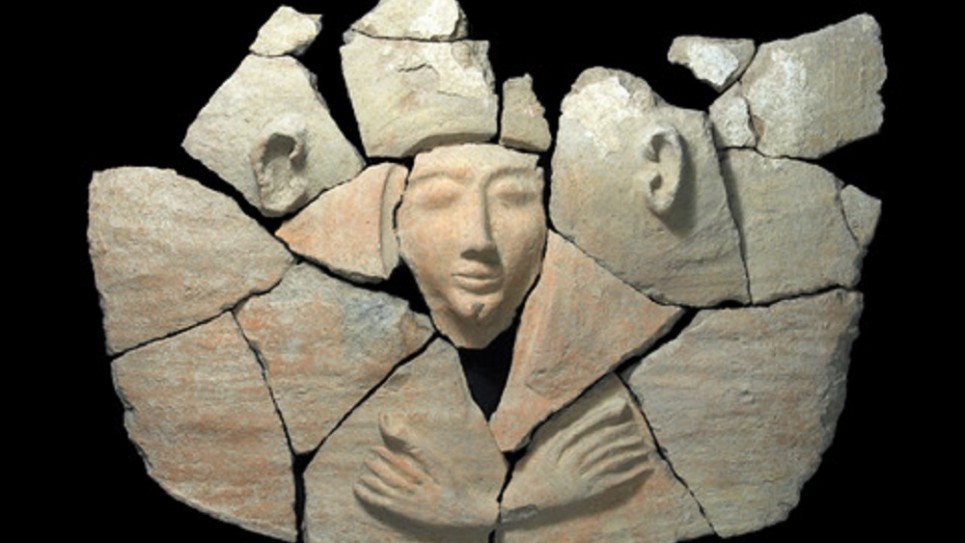Egyptian Quisling in Canaan? April 27, 2014
Author: Beach Combing | in : Ancient , trackbackThis year has been a particularly exciting one in Egyptology: the brewer’s tomb, a new pharaoh (and dynasty), Horemheb’s pyramid… Not least of the prizes has been a very unusual Egyptian grave found outside the bounds of the Nile valley. In fact, the grave in question was dug up in, of all places, ‘Canaan’ (Jezreel, Israel). A recent gas line dig saw workers stumble upon a beautiful sarcophagus – I use ‘beautiful’ too often on this blog, but surely the face above qualifies? – a skeleton and some Egyptian style objects including a golden seal of the Emperor Seti (obit c. 1279 BC). The general consensus is that this is an Egyptian tomb but not the tomb of an Egyptian. In other words though the burial recalls Egyptian customs it is unlikely that was have someone who was ethnically Egyptian; and, in fact, some of the objects interred were Canaanite. There are a few reasons for thinking this besides the local flavour: not least the fact that noble and also not so noble Egyptians were typically mummified (there was a simple skeleton here); and the fact that Egyptians had a horror of being buried outside Egypt. The land washed by the Nile’s ebb and flow was holy and it was there that the body needed to be interred if it was going to resurrect when Horus came to rule: this wasn’t just the question of an Italian immigrant longing to be laid in the cemetery of his forefathers for sentimental reasons, burial in Egypt had important religious consequences for the afterlife. So who was this Canaanite (?) who decide to be buried with the seal of Seti? He was very likely an official ruling the north lands for an Egyptian master. Egyptian power, like the Nile, ebbed and flowed in the ancient world: at its height the Egyptians controlled the roads down into Nubia, the deserts of Libya and as far north as Syria; in fact, one of the highlights of Seti’s reign was the capture of the Syrian city of Kadesh, a remarkable achievement for an Egyptian army. Yet these moments of Egyptian ambition were transient and the Egyptians never really seemed to have imposed their culture on alien peoples: there was no equivalent of olive oil on Hadrian’s Wall or cricket in Pakistan. There was a bit of kicking, spitting and then, at best, tribute. At least, that is how most Egyptologists have seen Egyptian imperialism. And this is why this grave is so exciting. It shows a glimpse of a colonial ‘Egyptian’ society in other lands, where and when it was little expected. It also hints at a period when interlocking connections between the regions were producing unusual synergies. Sorry for that ghastly sounding sentence, been reading a lot of academic prose recently. However, this period does matter. It is, by most chronologies, the generation before Joseph and his brothers (whatever that legend really means), and, more interestingly still, a century or so before Moses emerged from Egypt with massive consequences for Judaism and Christianity. You get a flavour then of epochal changes in the sarcophagus’ smile. Other thoughts on this fascinating grave: drbeachcombing AT yahoo DOT com
27 April 2014: KMH writes: As one adhering to the early date for the Exodus (c. 1446 BC), the grave could be of a loyal Canaanite subject of Seti I who participated in his first year campaign in Canaan and Lebanon. These loyal Canaanites could have originally fled into Egypt during the Israelite conquest c.1406-1400 under Joshua. They may have partially assimilated into Egyptian culture, since a true return to Canaan as a group wasn’t possible in practical terms. The grave contains a descendant of this group who was given the honor of burial in his ancestral land, perhaps for his military heroism. Canaan was always regarded as an outlying district (largely autonomous) by Egypt, even though the Israelites believed otherwise. For the Israelites, it would have been a low point in their history since it was the period of the Judges, where unity between tribes was a central problem. We need to keep digging for the truth!’ Thanks KMH



